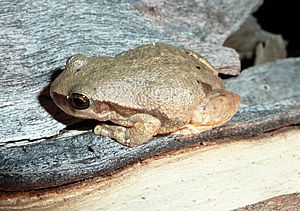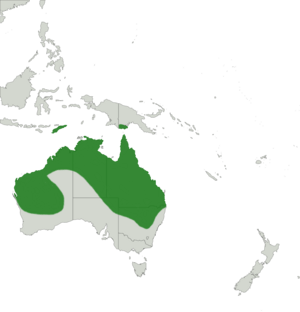Desert tree frog facts for kids
Quick facts for kids Desert tree frog |
|
|---|---|
 |
|
| Conservation status | |
| Scientific classification | |
 |
|
| Desert tree frog distribution | |
| Synonyms | |
|
The desert tree frog (Litoria rubella) is a small, fascinating frog. It's also known by other names like the naked tree frog or red tree frog. You can find these frogs in Papua New Guinea, Indonesia, and the northern parts of Australia.
Contents
What Does the Desert Tree Frog Look Like?
Adult male desert tree frogs are about 3.1 to 3.5 centimeters long. Female frogs are a little bigger, measuring 3.3 to 3.7 centimeters. That's about the length of your thumb!
These frogs are usually light brown. They often have darker brown spots on their skin. A dark brown stripe runs down each side of their body. You might also notice bright yellow coloring on their legs.
Where Does the Desert Tree Frog Live?
The desert tree frog is very adaptable. It can live in many different places. You might find it in swamps, near streams, or even in ditches.
These frogs often live close to people. They are known to climb into pipes around human houses. This helps them find shelter and stay cool.
Life Cycle of the Desert Tree Frog
Desert tree frogs lay their eggs on the surface of still water. This means water that isn't moving, like in a pond. They can lay a lot of eggs at once, usually between 30 and 300!
Once the eggs hatch, tiny tadpoles emerge. These tadpoles grow very quickly. In just about two weeks, they transform into small frogs. This fast growth helps them survive in places where water might dry up quickly.
Images for kids
See also
 In Spanish: Litoria rubella para niños
In Spanish: Litoria rubella para niños



